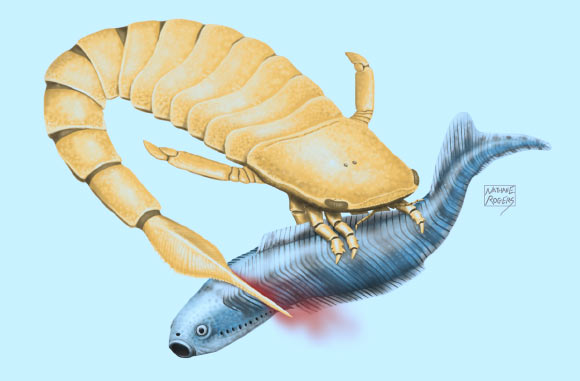Eurypterids, better known as sea scorpions, used their serrated-spine-tipped tails to dispatch their prey, according to new research by University of Alberta paleontologists Scott Persons and John Acorn.
Sea scorpions are an extinct group of aquatic arthropods that are ancestors of modern spiders, lobsters, and ticks.
The group is taxonomically diverse, with more than 20 families recognized and known from abundant fossil specimens.
These creatures thrived in warm shallow waters, in both seas and lakes, around the world after the Cambrian explosion: from the Ordovician to the Permian periods (460 to 248 million years ago).
They were formidable predators and ranged in size from 6 inches (15 cm) to 76 inches (2 m).
They had thin, flexible bodies. Some species also had pinching claws.

Slimonia acuminate: (A) articulated preabdomen (pre I–VII), postabdomen (post I–V), and telson (t) segments preserved in a strong lateral curve; (B) close-up of the serrated telson spine. Scale bar – 5 cm. Image credit: W. Scott Persons IV & John Acorn, doi: 10.1086/691967.
According to the new study, published in The American Naturalist, sea scorpions had another weapon at their disposal: a serrated, slashing tail spine.
“Our study suggests that sea scorpions used their tails, weaponized by their serrated spiny tips, to dispatch their prey,” Dr. Persons said.
He and his colleague, Dr. Acorn, reached this conclusion after the discovery of a well-preserved specimen of the Silurian sea scorpion Slimonia acuminata with a serrated-spine-tipped tail curved strongly to one side.
The fossil was collected from the Patrick Burn Formation near Lesmahagow, Scotland.
“Unlike lobsters and shrimps, which can flip their broad tails up and down to help them swim, Slimonia acuminate tails were vertically inflexible but horizontally highly mobile,” the researchers said.
“This means that these sea scorpions could slash their tails from side to side, meeting little hydraulic resistance and without propelling themselves away from an intended target,” Dr. Persons said.
“Perhaps clutching their prey with their sharp front limbs eurypterids could kill pretty using a horizontal slashing motion.”
_____
W. Scott Persons IV & John Acorn. A Sea Scorpion’s Strike: New Evidence of Extreme Lateral Flexibility in the Opisthosoma of Eurypterids. The American Naturalist, published online April 18, 2017; doi: 10.1086/691967








